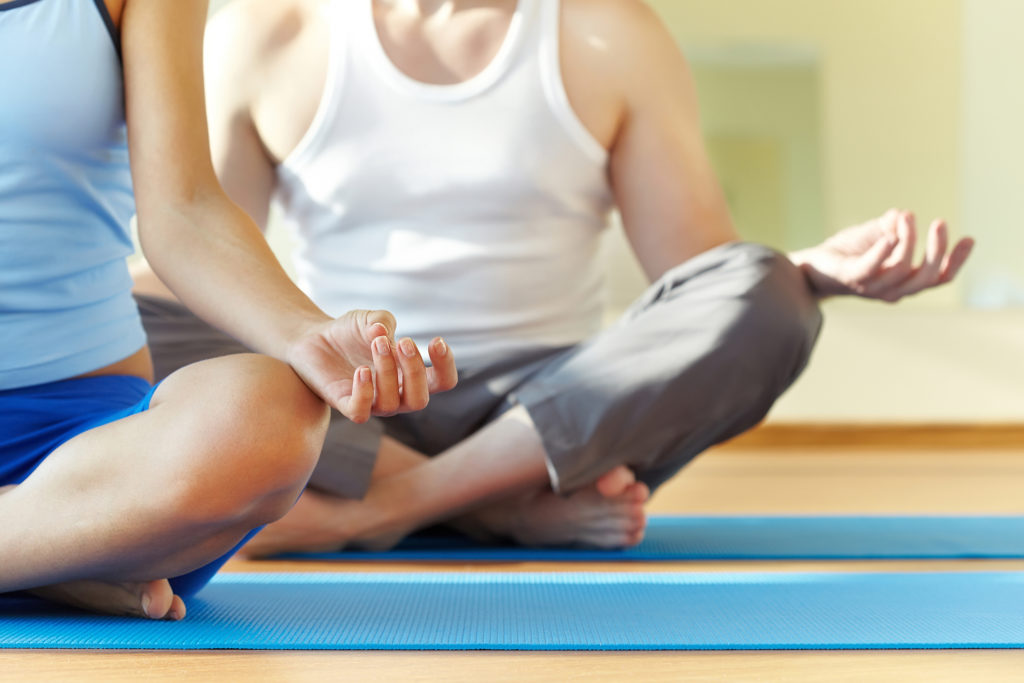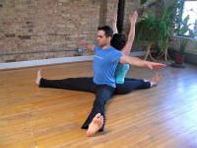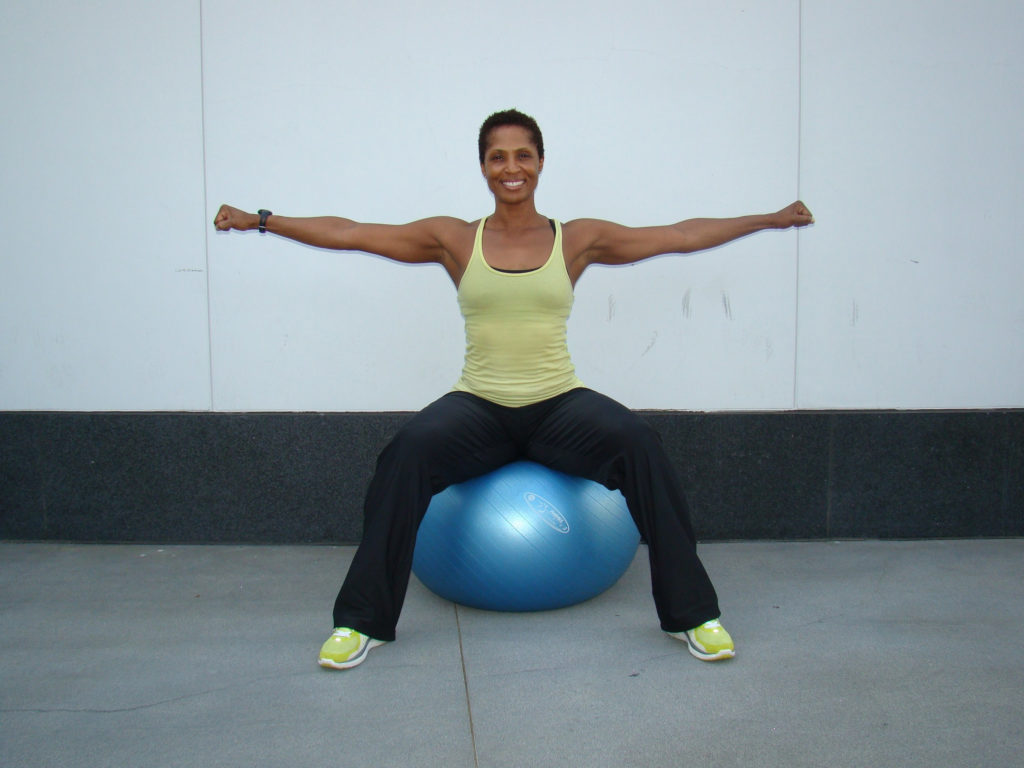Archive for September 2011
burning the midnight oil and poor dietary choices
If you or any of your clients like to stay up late and then sleep in, you might want to consider resetting your body clocks. A Northwestern University study, published in the July issue of Obesity, reports that people with night-owl behavior tend to consume more calories, eat more fast food, and drink more sugary sodas than those who practice an early-to-bed and early-to-rise routine.
Read MoreStroke Survivors Benefit From Yoga Therapy
An 8-week yoga therapy course helped older stroke survivors improve balance, endurance and confidence in a pilot study presented at the American College of Sports Medicine’s 58th Annual Meeting. Researchers from Indiana University–Purdue University and the Richard L. Roudebush VA Medical Center (Roudebush VAMC), both in Indianapolis, sought to explore whether yoga practice would help stroke survivors reduce the risk of falls, since an estimated 80% of people who have strokes also have impaired balance. Poor balance increases the risk of falls and of hip fractures.
Read MoreTips to Improve Mental Wellness
A lot of focus is placed on improving physical wellness, but mental wellness doesn’t always receive equal emphasis. To address this issue, Daniel J. Siegel, MD, clinical professor of psychiatry at the University of California, Los Angeles, School of Medicine and founder of the Mindsight Institute, and David Rock, founder of the Neuroleadership Institute, have created “The Healthy Mind Platter,” a pictorial example of activities that can help people cultivate optimum mental health.
Read Morekohlrabi and red lentil stew
Hearty and filling, this stew is easy to prepare on a busy weeknight with flavors that will brighten an autumn night, as well as pack a good dose of iron and vitamins A and C to rev up your immune system.
The kohlrabi maintains its crispness, providing a nice contrast to the red lentils, which become the consistency of mashed potatoes. If kohlrabi isn’t available, substitute broccoli stem for the kohlrabi and use the broccoli florets instead of the spinach.
Read MoreKohlrabi
When people first see or taste kohlrabi, they commonly react by asking, “What is that?” Sometimes described as octopus-like or as a creature from outer space, kohlrabi has trailing tendrils protruding from a pale-green, softball-sized globe.
Read Morefood labels confound consumers
Results of a recent telephone survey commissioned by the Center for Science in the Public Interest (CSPI) revealed that a significant percentage of consumers seem confused about what constitutes a proper serving size of certain packaged foods.
Read Morehigh-calorie and high-sodium items most prevalent in kids’ fast-food choices
Kids may like the food, and parents may appreciate the convenience, but are the poor nutritional consequences of fast food worth it? A recent study by University of California, San Diego (UCSD), pediatrics researchers showed that fast-food lunches accounted for 36%–51% of a child’s daily caloric needs, with fat contributing 35%–39% of the calories. The meals also provided more than 50% of the recommended total daily sodium intake for most children—and as much as 100% of sodium levels recommended for preschoolers.
Read Moreask the RD
Question:
I’ve seen inulin listed as an ingredient in more and more food products. What is it, and is it healthy?
Read Moreeater emptor: some restaurant calories higher than advertised
It has become fairly common to see calorie counts listed next to restaurant menu items. This helpful check for on-the-go eaters can prompt practical choices when calories are a concern. However, a new study of foods found in national chain restaurants suggests that some items contain more calories than listed.
Read Morecan most americans even afford to eat a healthy diet?
With recession still threatening and unemployment numbers remaining high, more Americans must make tough choices about the type and quality of food they are putting on the table. A study published in the August issue of Health Affairs underscores this, saying that a healthy diet is expensive and could make it difficult for Americans to meet the new U.S. nutrition guidelines. These guidelines, an update of what used to be known as the food pyramid, call on Americans to eat more foods containing potassium, dietary fiber, vitamin D and calcium.
Read MoreFrom 1998 to 2011: ACSM Publishes Updated Exercise Guidelines
Garber, C.E., et al. 2011. Quantity and quality of exercise for developing and maintaining cardiorespiratory, musculoskeletal, and neuromotor fitness in apparently healthy adults: Guidance for prescribing exercise. Medicine & Science in Sports & Exercise, 43 (7), 1334–59.
Read MoreSelf-Determination Theory: A Key to Motivation
Self-determination theory (SDT) is a theory of motivation that aims to explain individuals’ goal-directed behavior. Motivation resides along a continuum, with intrinsic motivation on the far right, extrinsic motivation in the middle and amotivation on the far left. Intrinsic motivation is ideal; people engage in an activity because of internal factors and are therefore likely to sustain the activity for their own reasons.
Read MoreIncorporating Mindfulness Into Your Personal Training Sessions
Teaching clients to calm their minds during movement is essential to helping them fight stress and achieve their wellness goals.
We must not underestimate how much our clients suffer from stress. Sure, it distracts them during training sessions, but it also infects every facet of their daily lives. Fortunately, time-tested yoga techniques for developing mindfulness and flow can help clients focus on their fitness goals and cope with stress outside the gym.
Read MoreEmployment Opportunities in Senior Living
You’re passionate about the value of fitness in a wellness lifestyle. You’ve educated yourself on exercise science and leadership. Perhaps your training is in yoga, Pilates, tai chi or another approach. Now you’re ready to help others gain the benefits of your knowledge. It’s time to get to work.
Read MorePartner Pilates: 3 Fun Moves
In much the same way that Pilates equipment provides assistance and resistance, Partner Pilates helps participants find the proper muscles to execute an exercise effectively.
Read MoreHigh Trainer Turnover? Solutions
Many personal trainers are promoted to manager or director solely on the basis of their success as a trainer and not necessarily because of their management skills.
Read MoreStability Ball Challenge
You’ve spent a lot of time and energy working on your class, and you’re ready to wow your students with another great workout. But wait: How much effort did you really put into that warm-up? Not only does the warm-up set the stage for what’s to come; it also ensures a safe and effective environment for students. Don’t skim over this crucial opportunity to make a lasting impression. Wake up your warm-up with these fun and functional moves.
Nothing says “creativity” quite like the stability ball, a staple in many group exercise studios. Before you turn the page—or turn up your nose—at the idea of using the stability ball in your warm-up, let’s explore the benefits of the ball and how simple exercise patterns that use it can create a unique and exhilarating prelude to any class format.
More Than Play
The primary benefit of using the stability ball—as opposed to moving on a hard, flat surface—is that the body responds to the instability by trying to remain balanced. This action engages multiple muscle systems. Also, the ball activates the neuromuscular system in a way that not many pieces of equipment can. Finally, the stability ball tends to take the “work” out of working out.
Let’s look at five basic moves you can insert into a warm-up for almost any class.
Basketball Drill
Stand tall, feet hip width apart, and hold the ball at waist level. Bounce the ball with both hands as you try to keep rhythm with the music. Increase the difficulty by adding a step-touch. This exercise elevates the heart rate, develops hand-eye coordination skills and is perfect for any sculpting or boot camp class.
Basic Bounce and Hip Circles
Sit on the ball, feet about hip distance apart, heels down, and bounce up and down. Hold the sides of the ball if needed; otherwise, extend the arms back into a triceps extension on each downbeat. Think of bouncing up—almost off the ball—instead of being heavy and bouncing down “into” the ball. This will loosen up the low-back muscles and get your heart rate pumping. Add hip circles once you stop bouncing (the two moves work well together). Draw a circle with your hips, 8-10 times in one direction and then 8-10 times in the opposite direction. This is a great way to begin any dance-based workout.
Walk Back to Plank
Stand with feet about hip distance apart, holding the ball comfortably at your waist. Place the ball on the floor as you step the right (R) leg back. Steady yourself as you step the left (L) leg back, hold a few seconds and then step the L leg in, followed by the R, and return to standing. This exercise fires up the core and low-back muscles and is a good way to prepare for any sculpting-based routine.
Squat Circles With Side Leg Lift
Stand with feet a little wider than shoulder width apart, holding the ball at your waist. Squat as you make a big circle with your arms, and come back up, completing the circle, to squat once more. Continue circling, but pause as you reach the ball overhead and out to the R, abducting the L leg. Repeat 5 times to the R and then immediately switch to the L. This full-body move works well within a dance-based or conditioning format.
Jumping Jacks
Sit on the ball, feet together in front, arms folded in, knuckles together at chest. Bring your arms out and in as you bounce, letting the legs follow the arms (i.e., as the arms go out, so do the feet and vice versa). This is a surefire way to elevate body temperature; therefore, alternate between jumping jacks and basic bounces. This combination is ideal for interval-based classes because right away you’re implementing short, intense cardio bursts followed by brief recovery periods.
Step up and throw a curve ball (or stability ball) at your students! Give them something different and add a little bounce to your basic warm-up. This simple, versatile piece of equipment will improve functional strength, balance and flexibility and add variety to your existing class protocol.
Read MorePersonal Training Trends: What’s New
Nearly 700 IDEA personal trainer members—mostly independent, small-business entrepreneurs—completed the 2011 IDEA Personal Trainer Programs & Equipment Trends survey. Read on to discover what they are seeing in their day-to-day operations, why they are making certain decisions about programming and equipment and how they are positioning themselves for 2012 and beyond.
Topline Trends
The most popular trends emerging from the 2011 data show that IDEA trainers continue to incorporate small, portable equipment into small-group training sessions that focus on body weight leverage training, functional resistance training and balance training. Results further show that these trainers believe specialized client populations, such as older adults and those in need of weight management or back pain prevention programs, are growing. This, in turn, means that professionals need more continuing education to remain current and effective in their service.
Survey respondents reaffirmed that training adults one-on-one remains the mainstay of their training businesses. Sessions focus most often on cardiorespiratory cross-training, strength training, stretching, functional resistance training and balance training.
Top 10 Programming Trends
This year we asked IDEA personal trainers to report their picks for the top programming trends in the industry. Participants were asked to respond yes or no to a list of more than 30 possible programming trends. Write-in replies were also analyzed. Results fell into three main categories: training methods, special populations and organizational training formats.
p>Training Methods
The number-one programming trend is body weight leverage training, followed closely by functional resistance training and balance training. Two of the top three trends—functional resistance training and balance training—have been offered by at least 95% of respondents since 2008. Tied for fourth in popularity are senior-specific training and weight management training. Further down the list are cardiorespiratory interval training (tied for sixth with personal training, 2 clients share); nutrition coaching (eighth); and back pain prevention (tied for ninth with outdoor boot camp classes and personal training, 3-5 clients share). More than three-quarters of trainers who responded to the survey currently offer their clients these types of programs.
Special Populations
Consistent with the trends, Ray Vargas, owner of ISOTONEX Personal Training in San Jose, California, is keeping his eye on a few special populations. His top three picks are the weight management sector, seniors and clients needing postrehabilitation. “The reason for such growth is that these markets have remained untapped for many years, but now we are seeing the need for training at every phase of life. For an athlete, this may mean speed, agility and quickness, but for a senior citizen it may mean getting in and out of the house without breaking a hip,” Vargas observes.
Organizational Training Formats
Working with multiple clients—through personal training sessions that 2 clients share or 3–5 clients share, or through outdoor boot camps—ranks among the top 10 programming trends. Five-year trends data show that while 2 clients sharing and 3–5 clients sharing have both grown, outdoor boot camps—perhaps surprisingly—have shown no growth. Survey data regarding which types of facilities are more likely to offer shared sessions show equality across facility types, with slightly fewer group sessions available at the trainer’s home.
For detailed survey results, please see the complete article, “2011 IDEA Personal Trainer Programs & Equipment Trends” online in the IDEA Library or in September 2011 IDEA Fitness Journal.
Read MoreDon’t Be That Manager: High-Pressure
Many personal trainers are promoted to manager or director solely on the basis of their success as a trainer and not necessarily because of their management skills. Now it’s your turn: You are the new personal training manager. You’re finding out how different being the manager is from working with clients on the floor.
Read MoreThe Pay Rate Debate
If you’ve managed a group fitness department long enough, you’ve probably felt like the “red-headed stepchild” more than once. If your facility is like a host of others, your department isn’t considered a separate profit center, but rather a part of membership. Since group exercise doesn’t usually have a “home” on the profit and loss statement, payroll is often the only line item attributed to it. Consequently, when cuts are made, guess which department is most often flagged!
Read More










